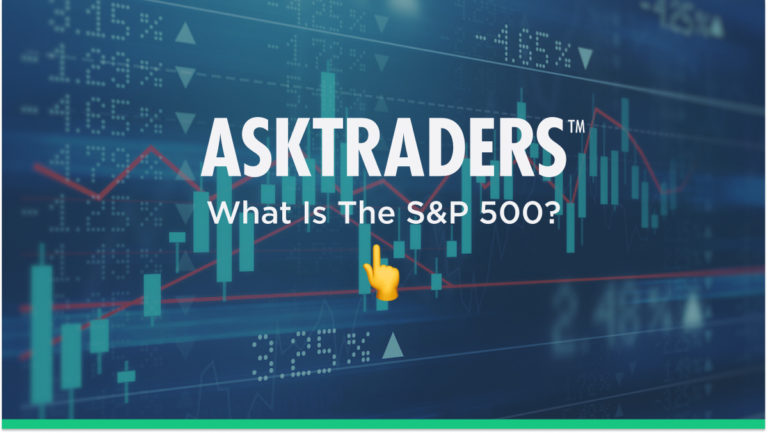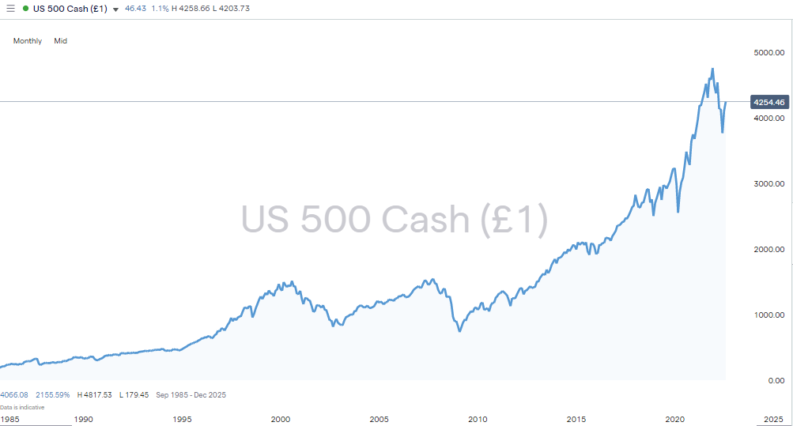
Whether you’re a newbie looking to get to grips with an important piece of jargon or an experienced investor, the S&P is a term that needs to be clearly understood. In fact, establishing what the S&P is, can help get a clearer take on what is taking place in the market and where it might be heading next.
What is S&P 500?
The Standard & Poor’s 500 index is an equity index, which was launched in 1957. It’s one instrument that represents a basket of stocks. The value of the index goes up and down in real-time and gives an instant insight into the health of a particular area of the stock markets. Its peer group includes other indices such as the FTSE, DAX, CAC, NASDAQ, and DJIA (Dow Jones Industrial Average), which measure the performance of stocks in other sectors and regions.
One defining feature of the S&P that makes it popular with analysts is that it is made up of the largest blue-chip companies listed in the US. That sector has traditionally been a prime target for institutional and retail investors.
The S&P 500 index is important because it is one of the best, and longest running gauges of prominent US stocks. As American equity investors tend to drive the direction of the global market, it is by extension used to gauge the health of stock markets in general. When analysts are discussing stocks in general, the S&P will often be the metric they use.
What Firms are Members of the S&P?
The aim of the index is to reflect the health of the largest US stocks rather than be an exercise in strict accounting methodologies. To achieve that aim, the Standard & Poor’s analysts and committee adopt an approach that has a degree of tolerance. One example of this is that, as of August 2022, there were 503 rather than 500 firms included in the index.
The top-five listed firms were Apple Inc, Microsoft Corp, Amazon Inc, Tesla Inc, and Alphabet Inc. The smallest member in terms of market cap was sportswear firm Under Armour Inc, from the consumer durables sector. The market caps of the firms ranged from $3.4bn to $2.6tn and the mean and median market caps were $72.8bn, and $29.9bn, respectively.
At the time of that reading, 27.9% of the index is made up by firms from the IT sector but there was a diverse range of firms from other sectors which included Healthcare stocks which made up 14.3% of the index, Financials 10.6%, Industrials 7.8%, Utilities 3.0%, Real Estate 2.9%, and Materials 2.5%.
The market-weighted element of the index means that the top 500 firms listed on US exchanges have a chance of being included, but there are other criteria that come into play. The S&P committee may decide to not include a firm, though it will not usually publicly declare its reasoning.
Zoom Inc, for example has a market cap greater than Under Armour but a high volatility share price, which could result in it flip-flopping in and out of the index at each rebalancing. Alternatively, firms such as KKR & Co Inc with a market cap of $44bn might not make the cut because of the nature of their business. KKR is an impressively successful private equity firm, which is listed on the NYSE, but it has long-term investment objectives and might not be what the S&P management are thinking of when creating a benchmark to reflect the health of the US stock market.
How the S&P 500 Works
The aggregate value of the S&P, and therefore its price, is made up by the individual valuations of the stocks which make it up.
For investors, that means a 5% rise in price by the 500th ranked stock would have less of a material impact on the price of the S&P than a 5% rise in value of one of the top-10. It’s an index of large-cap stocks in which the largest cap stocks have proportionately greater influence.
The process of calculating the value of the S&P starts with adding together the market cap of every company in the index. The weighting of each company can be determined by dividing the market cap of stock ABC Inc by the total value of the S&P. One element of ‘secret sauce’, which helps Standard & Poor’s keep their index the preeminent index for investors to use is the ‘divisor’. This metric is confidential proprietary property of Standard & Poor’s and is used to divide the aggregate market cap of all the firms and come up with one number to represent the price of the index.
S&P 500 Index – Monthly Price Chart. 1986 – 2022

Source: IG
What Happens When Firms Leave or Enter the S&P 500
The management team at Standard & Poor’s ultimately determine the criteria used to determine which firms are members of the S&P 500 and when stocks rotate in and out.
Firms enter or leave the index during the quarterly rebalancing. When a firm is subject to a merger or takeover and if the acquired firm is no longer listed on an exchange, it by default drops out of the S&P 500. In this instance the stock previously ranked 501 might be expected to be included going forwards. Firms that fall in value and have a market cap, which is no longer one of the top-500 can expect to lose their place in the index. Though this decision is made at the discretion of S&P.
In a similar manner, stocks of firms that are experiencing significant growth can achieve market caps that put them into position to have a claim to be included. The exact timing of when they will be included in the S&P is ultimately up to the discretion of Standard & Poor’s. Its analysts may hold off on including a stock in the belief that its spike in value is short-lived and including it would be subsequently followed by that stock falling in value and being expelled.
A stock with solid long-term prospects and a bona fide claim to be included in the S&P can experience additional buying pressure and support for its share price. In a form of arbitrage, speculators buy the stock in expectation of it being included in the S&P 500 at the next index reorganisation date. This is because once that happens, the huge S&P tracker funds, which mimic the index, will need to buy the new entrant to ensure their performance correlates as closely as possible to that of the index. The S&P 500 is an exclusive club and being a member of it can support a company’s share price.
What Determines the Price of S&P 500?
If you want to answer the question ‘is the S&P is going to go up or down’, then you will need to make a call on the underlying 500 stocks that form its constituent parts. Also factor in that the fortunes of the big names such as Apple and Microsoft will have a proportionately greater influence on the price of the index.
Determining if a stock is undervalued or not can be done using technical and fundamental analysis or stock forecasts. Given the popularity of the S&P 500 it is also possible to tap into free S&P 500 research which discusses the prospects of the index.
Other Major Stock Indices?
There are subtle differences between the way the world’s major stock indices are created. The manager of each index can apply different criteria to design an instrument that they think will be most useful for investors and they can also adapt their own rules and regulations over time.
The big difference between indices is the constituent parts. The NASDAQ 100 index, for example, is made up of 100 of the largest and most actively traded stocks on the tech-heavy NASDAQ exchange. Buying a NASDAQ 100 tracking fund would be a move towards greater risk-return than an investment in the S&P 500 – high-growth tech stocks tend to be high beta.
In the same way, the Russell 2000 index is made up of 2,000 US-listed small-cap stocks. Small cap stocks can be a higher risk-return proposition and the Russell 2000 is distinctive because it offers focussed exposure to the US economy. Its member firms might be mid-west Supermarket operators, rather than Johnson & Johnson, which is in the S&P 500, but as a multinational, it generates a lot of its revenue abroad.
There is obviously room for cross-over between the respective indices. Firms such as Apple Inc can currently be found in both the NASDAQ 100 and S&P 500 indices.

Source: iStock
Is Investing in the S&P a Good Idea?
The S&P 500 index is a proprietary piece of intellectual property that you can’t actually buy. But it is possible to invest in funds, including ETFs, which have the sole objective of tracking the index. These are professionally run, cost-effective, and have a good record of mirroring the performance of the underlying index. There are pros and cons to all types of investing but some of the reasons to invest in an S&P 500 index tracker are outlined below.
- Investing in the S&P can be a particularly attractive proposition for investors looking to gain exposure to the equity markets with the click of one button. S&P Tracker funds are widely available at good brokers and offer a silver-bullet for investors who want to buy-and-hold a low-maintenance, low-risk, equity position.
- Large cap US stocks are some of the most heavily traded in the world and that liquidity means pricing is efficient and costs low. Bid-offer spreads tend to be narrower the more trading activity there is in a market and brokers compete for business by offering promotions on commission charges.
- S&P 500 stocks offer a degree of security. The criteria laid out by S&P require the member stocks to be listed on regulated stock exchanges and have minimum levels of publicly tradable shares. They are by definition large-cap stocks. That means they have the critical mass and proven track records of being able to navigate a recession.
- S&P stocks are filtered by size alone, so stocks can come from a wide range of sectors. If you’re looking to diversify your portfolio, then an investment in and S&P 500 tracker would represent buying into stocks ranging from ExxonMobil in the Integrated oil and gas sector and Walmart Inc in the consumer staples sector.
- The important role the S&P 500 plays in the investment community makes it easy to keep track of your investment. The index and its future prospects are often discussed by market experts, so you won’t have to spend too much time catching up with how your investment is performing.
- Nothing is ever guaranteed in the markets, and household names that form part of the S&P 500 index could go bust. By investing in a fund-style product, there is less impact on overall performance if one of the five hundred stocks do go belly-up.
- Smaller stocks offer a more aggressive approach to risk-return, but if you’re looking for a tried-and-tested way to invest in stocks then the S&P could be for you.
Final Thoughts
The position of the S&P 500 index in the investment community can’t be underestimated. It is a bellwether of stock market performance and is closely followed by equity investors and news reporters, but even those running forex, crypto, or commodity, strategies use the index as a benchmark for ‘what’s going on in stocks’.
The usefulness of the index in terms of analysis is matched by its potential as an investment vehicle. While you can’t buy the index as such, you can buy cost-effective, reliable, user-friendly funds that track it. They provide some of the easiest ways to invest in the biggest and safest stocks, and make your money work harder than it does in a savings account. If you set up to trade with a trusted and reliable broker, you’re taking the first steps towards investing in a low-maintenance asset with a proven track record of delivering exactly what the majority of investors are looking for.
